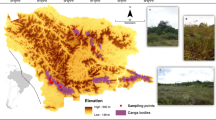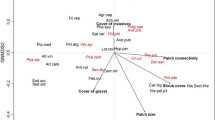Abstract
Context
A recent hypothesis, the habitat amount hypothesis, predicts that the total amount of habitat in the landscape can replace habitat patch size and isolation in studies of species richness in fragmented landscapes.
Objectives
To test the habitat amount hypothesis by first evaluating at which spatial scale the relationship between species richness in equal-sized sample quadrats and habitat amount was the strongest, and then test the importance of spatial configuration of habitat—measured as local patch size and isolation—when habitat amount was taken into account.
Methods
A quasi-experimental setup with 20 habitat patches of dry calcareous grasslands varying in patch size, patch isolation and habitat amount at the landscape scale was established in the inner Oslo fjord, Southern Norway. We recorded species richness of habitat specialists of vascular plants in equal-sized sample quadrats and analysed the relationship between species richness, habitat amount in the landscape and patch size and isolation.
Results
Although the total amount of habitat in a 3 km-radius around the local patch was positively related to species richness in the sample quadrats, local patch size had an additional positive effect, and the effect of patch size was higher when the amount of habitat within the 3 km-radius was high than when it was low.
Conclusions
In our study system of specialist vascular plants in dry calcareous grasslands, we do not find support for the habitat amount hypothesis.



Similar content being viewed by others
References
Alofs K, González A, Fowler N (2014) Local native plant diversity responds to habitat loss and fragmentation over different time spans and spatial scales. Plant Ecol 215:1139–1151
Andrén H (1994) Effects of habitat fragmentation on birds and mammals in landscapes with different proportions of suitable habitat: a review. Oikos 71:355–366
Bakkestuen V, Stabbetorp O, Molia A, Evju M (2014) The hotspot dry calcareous grassland in the Oslofjord region. Description of the habitat and a monitoring method developed in the ARKO project. NINA Report 1102
Brown JH, Kodric-Brown A (1977) Turnover rates in insular biogeography: effect of immigration on extinction. Ecology 58:445–449
Burnham KP, Anderson DR (2002) Model selection and multimodel inference: a practical information-theoretic approach. Springer, New York
Cain ML, Miligan BG, Strand AE (2000) Long-distance seed dispersal in plant populations. Am J Bot 87:1217–1227
Connor EF, McCoy ED (1979) The statistics and biology of the species-area relationship. Am Nat 13:791–833
Coudrain V, Schüepp C, Herzog F, Albrecht M, Entling MH (2014) Habitat amount modulates the effect of patch isolation on host-parasitoid interactions. Front Environ Sci 2:1–8
Cousins SAO, Vanhoenacker D (2011) Detection of extinction debt depends on scale and specialisation. Biol Conserv 144:782–787
Didham RK, Kapos V, Ewers RM (2012) Rethinking the conceptual foundations of habitat fragmentation research. Oikos 121:161–170
Evju M, Blumentrath S, Skarpaas O, Stabbetorp OE, Sverdrup-Thygeson A (2015) Plant species occurrence in a fragmented landscape: the importance of species traits. Biodivers Conserv 24:547–561
Evju M, Stange E (eds) (2016) Når artenes leveområder splittes opp-eksempler fra øyene i indre Oslofjord. Sluttrapport fra strategisk instituttsatsing (SIS) 2011-2015. NINA Temahefte 65
Ewers RM, Didham RK (2006) Confounding factors in the detection of species responses to habitat fragmentation. Biol Rev 81:117–143
Fahrig L (2003) Effects of habitat fragmentation on biodiversity. Annu Rev Ecol Evol Syst 34:487–515
Fahrig L (2013) Rethinking patch size and isolation effects: the habitat amount hypothesis. J Biogeogr 40:1649–1663
Fahrig L (2015) Just a hypothesis: a reply to Hanski. J Biogeogr 42:993–994
Fischer J, Lindenmayer DB (2007) Landscape modification and habitat fragmentation: a synthesis. Glob Ecol Biogeogr 16:265–280
Franzén M, Schweiger O, Betzholtz P-E (2012) Species-area relationships are controlled by species traits. PloS one 7:e37359
Giladi I, May F, Ristow M, Jeltsch F, Ziv Y (2014) Scale-dependent species-area and species-isolation relationships: a review and a test study from a fragmented semi-arid agro-ecosystem. J Biogeogr 41:1055–1069
Haddad NM, Brudvig LA, Clobert J, Davies KF, Gonzalez A, Holt RD, Lovejoy TE, Sexton JO, Austin MP, Collins CD, Cook WM (2015) Habitat fragmentation and its lasting impact on Earth’s ecosystems. Sci Adv 1(2):e1500052
Hanski I (1994) Patch-occupancy dynamics in fragmented landscapes. Trends Ecol Evol 9:131–135
Hanski I (2015) Habitat fragmentation and species richness. J Biogeogr 42:989–993
He FL, Hubbell SP (2011) Species-area relationships always overestimate extinction rates from habitat loss. Nature 473:368–371
Holland JD, Bert DG, Fahrig L (2004) Determining the spatial scale of species’ response to habitat. Bioscience 54:227–233
Jackson HB, Fahrig L (2015) Are ecologists conducting research at the optimal scale? Glob Ecol Biogeogr 24:52–63
Köchy M, Rydin H (1997) Biogeography of vascular plants on habitat islands, peninsulas and mainlands in an east-central Swedish agricultural landscape. Nord J Bot 17:215–223
Lid J, Lid DT (2005) Norsk flora, 7th edn. Det Norske Samlaget, Oslo
MacArthur RH, Wilson EO (1967) The theory of island biogeography. Princeton University Press, Princeton
Matthews TJ, Cottee-Jones HE, Whittaker RJ (2014) Habitat fragmentation and the species-area relationship: a focus on total species richness obscures the impact of habitat loss on habitat specialists. Divers Distrib 20:1136–1146
Mazerolle MJ (2016) AICcmodavg: Model selection and multimodel inference based on (Q)AIC(c). R package version 2:0–4. http://CRAN.R-project.org/package=AICcmodavg
Munguia-Rosas MA, Montiel S (2014) Patch size and isolation predict plant species density in a naturally fragmented forest. PloS one 9(10):e111742
Nakagawa S, Cuthill IC (2007) Effect size, confidence interval and statistical significance: a practical guide for biologists. Biol Rev 82:591–605
Pärtel M, Zobel M, Zobel K, van der Maarel E (1996) The species pool and its relation to species richness: evidence from estonian plant communities. Oikos 75:111–117
Pinheiro J, Bates D, DebRoy S, Sarkar D, R Development Core Team (2013) nlme: linear and nonlinear mixed effect models. R package version 3:1–109. http://www.r-project.org
R Core Team (2015) R: a language and environment for statistical computing. R Foundation for Statistical Computing, Vienna, Austria. http://www.R-project.org/
Reitalu T, Purschke O, Johansson LJ, Hall K, Sykes MT, Prentice HC (2012) Responses of grassland species richness to local and landscape factors depend on spatial scale and habitat specialization. J Veg Sci 23:41–51
Rosenzweig ML (1995) Species diversity in space and time. Cambridge University Press, Cambridge
Rybicki J, Hanski I (2013) Species-area relationships and extinctions caused by habitat loss and fragmentation. Ecol Lett 16:27–38
Saunders DA, Hobbs RJ, Margules CR (1991) Biological consequences of ecosystem fragmentation: a review. Conserv Biol 5:18–32
Schielzeth H (2010) Simple means to improve the interpretability of regression coefficients. Methods Ecol Evol 1:103–113
Shadish WR, Cook TD, Campbell DT (2002) Experimental and quasi-experimental designs for generalized causal inference. Houghton Mifflin, Boston
Silvertown J (2004) Plant coexistence and the niche. Trends Ecol Evol 19:605–611
Smith AC, Koper N, Francis CM, Fahrig L (2009) Confronting collinearity: comparing methods for disentangling the effects of habitat loss and fragmentation. Landscape Ecol 24:1271–1285
Sverdrup-Thygeson A, Gustafsson L, Kouki J (2014) Spatial and temporal scales relevant for conservation of dead-wood associated species: current status and perspectives. Biodivers Conserv 23:513–535
Villard M-A, Metzger JP (2014) Beyond the fragmentation debate: a conceptual model to predict when habitat configuration really matters. J Appl Ecol 51:309–318
Wiens JA (1989) Spatial scaling in ecology. Func Ecol 3:385–397
Williams CB (1943) Area and the number of species. Nature 152:262–265
Wilson MC, Chen XY, Corlett RT, Didham RK, Ding P, Holt RD, Laurance WF (2016) Habitat fragmentation and biodiversity conservation: key findings and future challenges. Landscape Ecol 31:219–227
With KA (2016) Are landscapes more than the sum of their patches? Landscape Ecol. doi:10.1007/s10980-015-0328-8
Wollan AK, Bakkestuen V, Bjureke K, Bratli H, Endrestøl A, Stabbetorp OE, Sverdrup-Thygeson A, Halvorsen R (2011a) Open calcareous ground with shallow soil in the Oslo fjord region-a hotspot habitat. Final report from period II of the ARKO project. NINA Report 713
Wollan AK, Bakkestuen V, Halvorsen R (2011b) Spatial predictive modelling of dry calcareous grasslands in the Oslofjord area. In: Halvorsen R (ed) The scientific basis for habitat monitoring in Norway-baseline surveys. University of Oslo, Olso
Acknowledgments
This study was carried out under the projects ‘‘Survey and monitoring of red-listed species’’ (ARKO, funded by the Norwegian Environment Agency), and ‘‘Management of biodiversity and ecosystem services in spatially structured landscapes’’ (funded by the Norwegian Research Council, grant 208434/F40). We are grateful to A. Often, O. Skarpaas, O.E. Stabbetorp and J. Wesenberg for fieldwork contributions, and to three referees for valuable comments to earlier versions of this manuscript.
Author information
Authors and Affiliations
Corresponding author
Electronic supplementary material
Below is the link to the electronic supplementary material.
Rights and permissions
About this article
Cite this article
Evju, M., Sverdrup-Thygeson, A. Spatial configuration matters: a test of the habitat amount hypothesis for plants in calcareous grasslands. Landscape Ecol 31, 1891–1902 (2016). https://doi.org/10.1007/s10980-016-0405-7
Received:
Accepted:
Published:
Issue Date:
DOI: https://doi.org/10.1007/s10980-016-0405-7




